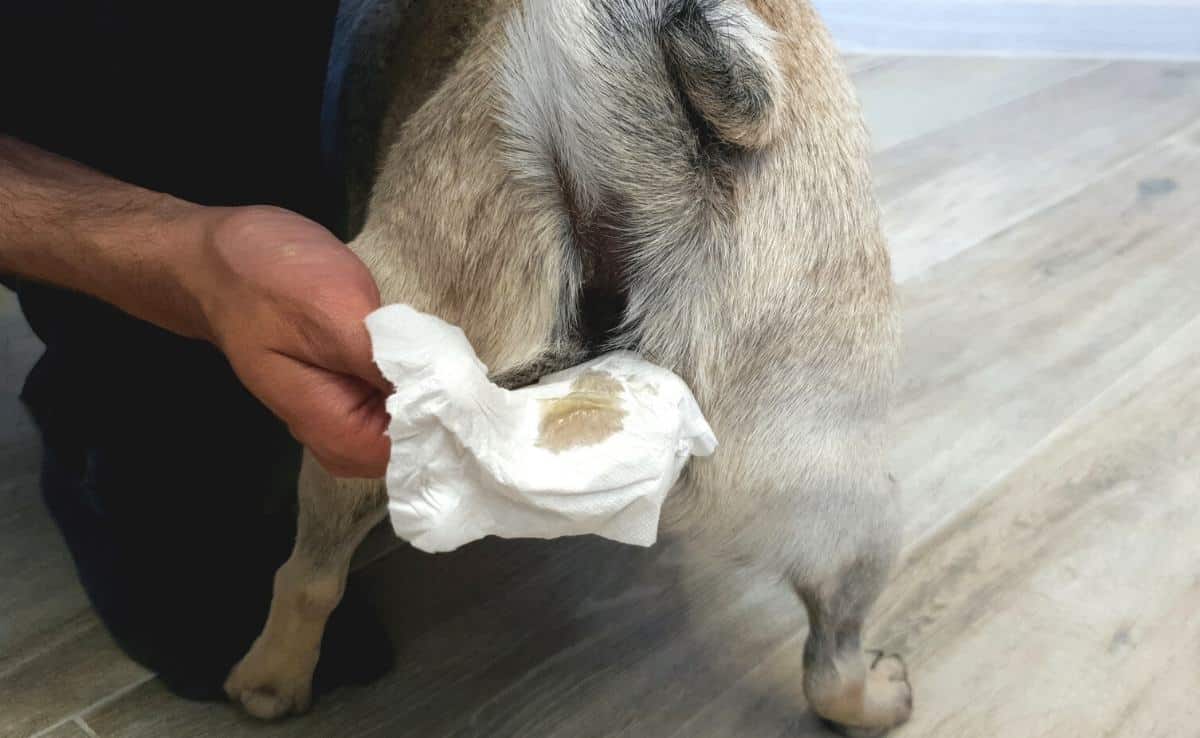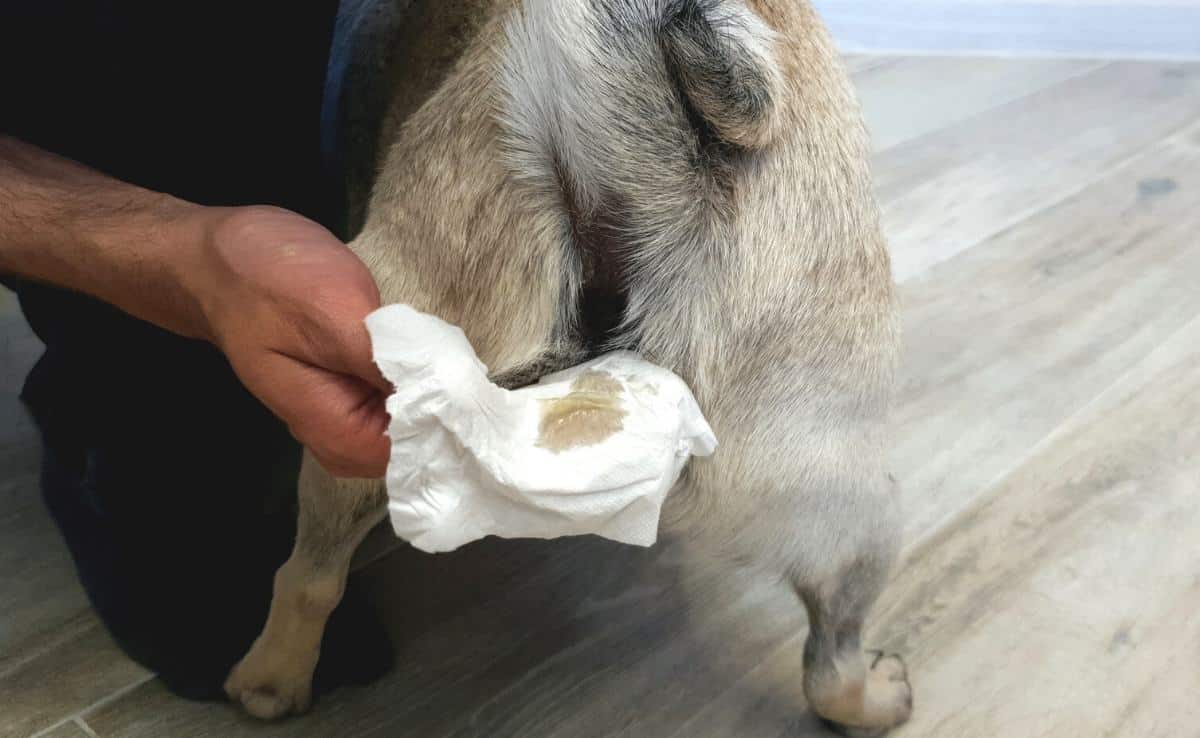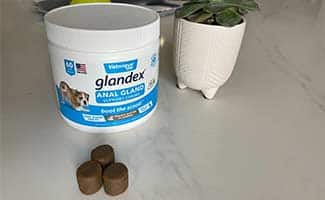
To keep the lights on, we receive affiliate commissions via some of our links. Our review process.

Anal glands are part of your dog’s normal anatomy. They form part of their natural scent and are used to mark territory and communicate with other canines. However, behaviors like scooting, licking the anus, and releasing the foul-smelling contents of these glands are less favorable behaviors our beloved canine friends perform.
What Are Anal Glands?
Contents
The anal glands or anal sacs are a small pair of glands, each about the size of a small grape, that sits just inside the anus between the internal and external sphincter muscles. If you imagined the anus to be a clockface, the glands would sit at the four and eight o’clock position.
All dogs have anal glands, which contain a strong-smelling liquid used for marking territory. Healthy anal glands empty naturally when a dog passes feces. Dogs can also consciously empty their anal glands in response to threat or fear to release a scent-marking material.
Dog anal gland smell is a distinct smell that you are unlikely to forget. It has been described as a ‘fishy’ or ‘musty’ smell. Chances are, most people agree they smell pretty terrible. The contents of the anal sacs drain out via two small ducts on either side of the anus. The secretions may range from yellow to brown in color and from watery to paste-like in consistency.
How To Express Anal Glands In Dogs
If the ducts that carry the anal sac material from the gland to the outside become blocked or inflamed and can no longer drain themselves, the anal glands need to be expressed or emptied. Anal glands can be expressed by a veterinary professional, dog groomer, or at home. This article explains how to express your dog’s anal glands at home.
You should only empty your dog’s anal sacs when they are showing symptoms of blocked glands. If you express them too frequently, it may increase the risk of impaction (or blocked).
If your dog appears painful when you express the glands, the material produced is bloody, or the glands are swollen or not easily expressed, then seek veterinary advice.
Which Breeds Of Dogs Are Prone To Anal Gland Problems?
All dogs can suffer from anal gland problems. However, problems such as impacted anal glands or dog anal gland infection are more common in smaller breed dogs such as Cocker Spaniels, Miniature Poodles, Poodle crosses, Lhaso Apsos, and Terriers than larger breed dogs.
Dogs that are overweight or have skin conditions (such as skin allergies, seborrhea, or skin infections) are more likely to suffer from anal gland problems. Diet can also play a big factor in anal gland health. Dogs that have inadequate dietary fiber are more likely to have issues. Allergies are also a possible cause of annual gland issues (both food and seasonal).
How To Clean A Dog’s Anal Glands
Most dogs sort anal hygiene problems out themselves by licking around the anus. If the contents of your dog’s anal glands are stuck around their anus or in their fur, then bathe with cool water or a dog-friendly shampoo.
The anal sacs themselves do not need cleaning, but certain anal gland issues, such as infection or sacculitis, require the glands to be flushed. This is a medical procedure that is performed by a veterinarian under sedation or anesthesia to treat recurring or resistant infections.
Symptoms Of Blocked Anal Glands In Dogs
The most common signs your dog may be having trouble with their anal glands include:
- Scooting
- Excessive licking or biting at their rear end
- Pain when pooing
- Anal discharge
- Pain when sitting down
Dog anal gland infection may also cause generalized illness associated with infection or high temperatures, such as a reduced appetite, lethargy, crying, or whimpering. Swelling or redness in the anal area can also be an indicator of anal gland issues that requires veterinary attention.
Types Of Anal Gland Issues
The main types of anal sac diseases are:
Anal Gland Impaction
Anal gland fluid can thicken and clog the ducts that drain the glands causing pressure to build inside, which can be uncomfortable. Impacted anal glands in dogs may result in frequent attempts to express the glands themselves by scooting or licking around the ducts.
Anal Gland Infection Or Abscess
The anal sac can become infected with bacteria resulting in inflammation (sacculitis) or an abscess. Swollen anal glands in dogs can be a sign of infection. You may see a red, hot, swollen mass next to the anus that is often painful to touch.
Ruptured Anal Gland Abscess
If an anal sac abscess is left untreated, it may rupture (or need to be medically ruptured) through the skin releasing green, yellow, or bloody discharge from the ruptured gland. Anal gland abscesses are often painful for dogs.
Anal Gland Cancer
Cancerous tumors can form in the anal sacs. The most common type of tumor is known as anal gland adenocarcinoma. Anal sac tumors are more common in female dogs than male dogs, and certain breeds of dogs are over-represented such as German Shepherds, Cocker Spaniels, and Dachshunds. Anal sac tumors appear as hard, sold masses within the gland that vary in size from the size of a pea to the size of a tennis ball, depending on how early they are detected.
Treating Anal Gland Issues In Dogs
Treatment of anal gland problems in dogs depends on the type of disease present. If your dog is showing signs of anal gland impaction and expressing the glands at home isn’t providing relief, then seek veterinary attention. Often medications are needed for anal gland infections, such as antibiotics, anti-inflammatories, and pain relief.
Some dogs require a medical procedure to flush the anal sacs, particularly if there is an anal gland abscess. If infections recur, then swabs may be taken for bacterial culture. Biopsies or samples of masses and swellings may also be taken. If dogs are experiencing a lot of pain with anal gland issues, then the examination of the glands may need to take place under sedation or general anesthesia.
If you suspect your dog has a ruptured anal gland abscess, then home treatment can involve gently bathing the area around the anus with cool water and cotton wool or a dilute saline solution while awaiting veterinary care. Dogs should avoid licking the area as this could make the infection worse. An e-collar or alternative is often needed to prevent them from irritating the area.
If your dog has ongoing anal gland issues, talk to your vet about possible diets or prescriptions to help prevent flare-ups. If your dog has had no preexisting conditions from previous anal gland issues, their anal gland expression or any diagnosis, treatment, and medication could be covered by your existing pet insurance policy.
Frequently Asked Questions
Do humans have anal glands like dogs?
Yes, sort of. The anatomy of the anus in humans is slightly different to dogs and other mammals but humans have similar glands classified as “eccrine-secreting sweat glands” that secrete fluid similar to sweat via the anal ducts.
How often do dogs need their anal glands expressed?
How often a dog needs its anal glands expressed depends on the individual. Dogs do not need their anal glands emptied routinely unless there is a problem. If your dog requires frequent anal gland expression, then this could indicate an underlying anal sac disease that may require veterinary attention. It is important to remember that behaviors such as scooting or licking around the anus may be caused by other problems, such as skin allergies or parasites, not just anal sac issues.
What happens if you don’t express your dog’s anal glands?
It is common for external anal gland squeezing to be offered at a grooming parlor, but it is unnecessary unless there is a problem. Anal glands are part of your dog’s normal anatomy, and they are designed to empty themselves in most healthy dogs. If you catch a whiff of a fishy smell in your dog’s rear area, the glands are likely full. If not emptied on their own, the anal sac can become impacted, causing discomfort. Not expressing them could lead to anal gland infection or abscesses.
What is the best high-fiber dog food for anal gland problems?
There are lots of high-fiber dog foods on the market, and many of these are marketed as weight-loss foods or prescription diets designed for diabetic dogs. The fiber content of food can be increased at home by adding vegetables, bran, or pumpkin to your dog’s diet.
Fiber supplements may also help and we have found Glandex to be the most helpful for our dog. It is recommended to seek veterinary advice before changing your dog’s diet.
Our First-Hand Experience With Glandex

Ever since we started using Glandex daily, our 3-year-old dog Barley has been anal gland issue-free. This easy and healthy solution has been a true gift for us and would recommend it to anyone whose dog is experiencing this health concern.
– Michelle S., Canine Journal
Anal gland problems such as dog anal gland infection impacted anal glands or anal gland abscesses are common and frustrating problems that affect lots of pets. While many dogs express the glands themselves by displaying natural behaviors such as scooting or licking the anus, excessive attention to their glands may indicate a problem. Anal gland problems left unchecked.
How To Keep Your Dog’s Anal Glands Healthy
There are some simple precautions you can take at home to reduce the chance of your dog suffering from anal gland problems. Keeping your dog at a healthy weight is essential as overweight dogs may have weaker muscles around their bottom which makes gland emptying more difficult. Diet changes can also be helpful if your dog is having problems with his or her glands. Adding extra fiber to your dog’s food can help to firm up and bulk out their poo which helps to express the glands as they defecate. If your dog is known to have anal gland problems, then regular checks with your veterinarian may be needed to spot problems developing early. Learn more about other gastrointestinal problems for dogs, including constipation.
Tagged With: Gastrointestinal